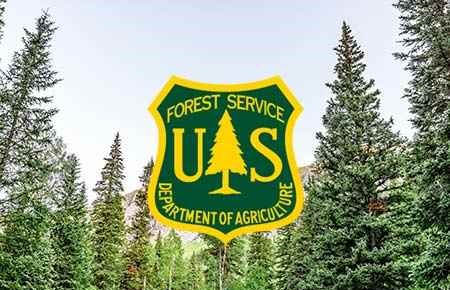
Forest and Conservation Worker
Summary
Forest and conservation workers measure and improve the quality of forests.
What they do
Forest and conservation workers typically do the following:
- Plant seedlings to reforest land
- Clear away brush and debris from trails, roadsides, and camping areas
- Count and measure trees during tree-measuring efforts
- Select or cut trees according to markings, sizes, types, or grades
- Spray trees with insecticides and fungicides to kill insects and fungi and to protect the trees from disease
- Identify and remove diseased or undesirable trees
- Inject vegetation with insecticides and herbicides
- Help prevent and suppress forest fires
- Check equipment to ensure that it is operating properly
Forest and conservation workers are supervised by foresters and forest and conservation technicians, who direct their work and evaluate their progress.
Forest and conservation workers perform basic tasks to maintain and improve the quality of the forest. They use digging and planting tools to plant seedlings and power saws to cut down diseased trees.
Some work on tree farms or orchards, where they plant, cultivate, and harvest many different kinds of trees. Their duties vary with the type of farm and may include planting seedlings or spraying to control weed growth and insects.
Some forest and conservation workers work in forest nurseries, where they sort through tree seedlings, discarding the ones that do not meet standards. Others use hand tools or their hands to gather woodland products, such as decorative greenery, tree cones, bark, moss, and other wild plant life. Some may tap trees to make syrup or chemicals.
Forest and conservation workers who are employed by or are under contract with state and local governments may clear brush and debris from trails, roads, roadsides, and camping areas. They may clean kitchens and restrooms at recreational facilities and campgrounds.
Workers with a fire protection background help to suppress forest fires. For example, they may construct firebreaks, which are gaps in vegetation that can help slow down or stop the progress of a fire. In addition, they may work with technicians to determine how quickly fires spread and how successful fire suppression activities were. For example, workers help count how many trees will be affected by a fire. They also sometimes respond to forest emergencies.
Work Environment
Forest and conservation workers work mainly in the western and southeastern areas of the United States, where there are many national and state forests, and on private forests and parks.
Forest and conservation workers work outdoors, sometimes in remote locations and in all types of weather. Workers use proper safety measures and equipment, such as hardhats, protective eyewear, and safety clothing.
Most of these jobs are physically demanding. Forest and conservation workers may have to walk long distances through densely wooded areas and carry their equipment with them.
How to become a Forest and Conservation Worker
Forest and conservation workers typically need a high school diploma before they begin working. Most workers receive training on the job.
Forest and conservation workers typically need a high school diploma and a valid driver’s license before they begin working. Some vocational and technical schools and community colleges offer courses leading to a 2-year technical degree in forestry. The programs typically offer courses in forest management technology, wildlife management, conservation, or timber harvesting. Programs that include field trips to watch and participate in forestry activities provide particularly good background knowledge.
Entry-level forest and conservation workers generally get on-the-job training as they help more experienced workers. They do routine labor-intensive tasks, such as planting or thinning trees. When the opportunity arises, they learn from experienced technicians and foresters who do more complex tasks, such as gathering data. Workers also learn safety procedures, including how to operate equipment safely and how to maintain safety gear.
In addition, some states require that crews and individuals receive training, and sometimes a license, in the use of commercial pesticides.
Pay
The median annual wage for forest and conservation workers was $31,770 in May 2019. The median wage is the wage at which half the workers in an occupation earned more than that amount and half earned less. The lowest 10 percent earned less than $22,770, and the highest 10 percent earned more than $46,870.
Job Outlook
Employment of forest and conservation workers is projected to show little or no change from 2019 to 2029. Although demand for forestry products and services will likely be steady, it is expected to be counteracted by the automation of much of the work that these workers do.
New technologies, such as remote sensing, allow fewer workers to perform certain tasks, such as tree counts and tree identifications. As the automation of manual forest tasks continues, fewer of these workers will be needed to perform the same amount of work.
Despite heightened international demand for U.S. timber and wood pellets that will continue to demand forest and conservation workers, improved technology will also lessen the need for workers to perform certain tasks.
Similar Job Titles
Conservation Officer, Crew Leader, Field Laborer, Foreman, Forest Resource Specialist, Forestry Support Specialist, Geographic Information Systems Coordinator (GIS Coordinator), Park Maintainer, Reforestation Worker, Tree Planter
Related Occupations
Surveying Technician, Agricultural Technician, Forest and Conservation Technician, Pesticide Handler/Sprayer/Applicator (Vegetation), First-Line Supervisor of Construction Trades and Extraction Workers
More Information
The trade associations listed below represent organizations made up of people (members) who work and promote advancement in the field. Members are very interested in telling others about their work and about careers in those areas. As well, trade associations provide opportunities for organizational networking and learning more about the field’s trends and directions.
- American Fisheries Society
- Mid-America Christmas Tree Association
- National Christmas Tree Association
- Society of American Foresters
Magazines and Publications
Content retrieved from: US Bureau of Labor Statistics-OOH www.bls.gov/ooh,
CareerOne Stop www.careeronestop.org, O*Net Online www.onetonline.org
